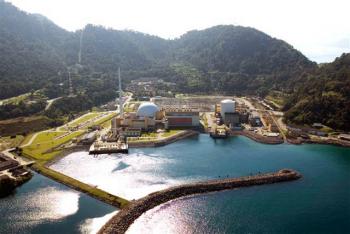
In 2016, gross electricity production in Brazil was 579 TWh. Of this total, 3% is produced by nuclear power plants (16 TWh).
Currently, Brazil has two nuclear plants in operation: Angra 1 and Angra 2.
Private investment in nuclear energy is not allowed, although this is under review.
Brazil began developing nuclear technology in 1951 under the newly created National Research Council. However, it accelerated this under a military regime from 1964 to 1985.
| Centrales nucléaires | Reactores | |
|---|---|---|

|
Angra. Itaorn, Rio de Janeiro | 3 |
Start of the Angra nuclear power plants
In 1970, the government decided to seek bids for the construction of a nuclear power generation plant. The contract for the construction of the Angra 1 plant was awarded to Westinghouse.
Construction began in 1971 on a coastal site between Rio de Janeiro and São Paulo. It is located on the Itaorna beach, in Angra dos Reis.
This is now the complex of the Almirante Álvaro Alberto Nuclear Power Plant (CNAAA) in the state of Rio de Janeiro (Brazil), 130 km west of Rio.
Angra 1 suffered from ongoing problems with its steam supply system and was shut down for some time during its early years. Its lifetime load factor for the first 15 years was only 25%, but since 1999 it has been much better.
Agreement for the construction of 8 nuclear reactors
In 1975, the government adopted a policy to be completely self-sufficient in nuclear technology and signed an agreement with West Germany for the supply of eight 1300 MWe nuclear units over 15 years.
The first two nuclear reactors (Angra 2 and 3) would be built immediately, with equipment from Kraftwerk Union (KWU).
The rest had 90% Brazilian content under the technology transfer agreement. To achieve this, a state company Empresas Nucleares Brasileiras SA (Nuclebrás) was created with several subsidiaries focused on particular aspects of nuclear fuel cycle and engineering.
However, Brazil's economic problems caused the construction of the first two Brazilian-German reactors to be halted, and the entire program was reorganized in the late 1980s.
Construction of Angra 2 resumed in 1995 and began operation in late 2000.
Angra 3, The last nuclear plant
After reviewing the 2013 policy, in May 2015, the government said Angra 3 would be the last nuclear power plant built as a public works project, paving the way for private capital in the next four units.
Nuclear energy and military influence in Brazil
There is continuing military influence on Brazil's nuclear program.
Brazil is the only state without atomic bombs or nuclear weapons in which the military leases uranium enrichment technology to the civilian nuclear program, and the navy drives technological advances in the nuclear field.
It is also the only state without nuclear weapons to develop a nuclear-powered submarine.
In what situation is the Angra 3 nuclear power plant in Brazil?
Angra 3 was designed to be a twin of Unit 2.
Work began on the project in 1984 but was discontinued in 1986 before full construction began.
In November 2006, the government announced plans to complete Angra 3 and also build another four 1,000 megawatt electric (MWe) nuclear plants starting in 2015 on one site.
In 2010 the construction of Angra 3 was restarted, in June 2010. The National Nuclear Energy Commission (CNEN) was the entity in charge of supervising the works.
Two Brazilian consortiums bid for installation contracts worth a total of 2.98 billion reais (1.456 million dollars).
Following a corruption investigation in mid-2015, Eletrobras suspended both contracts. At present, the construction of Angra 3 is suspended.
Uranium resources in Brazil
Brazil has uranium mines. It is estimated that they contain 278,000 tons of natural uranium, which represents 5% of the world total.
The three main uranium mines in Brazil are:
-
Pocos de Caldas (Minas Gerais state; mine closed in 1997)
-
Lagoa Real o Caetité (state of Bahía; operational since 1999);
-
Itataia, now called Santa Quitéria (state of Ceará; extraction has not yet started).